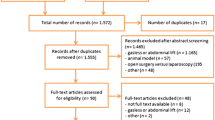Abstract
Background: The influence on intraperitoneal tumor growth of the choice of gas and pneumoperitoneum pressure during laparoscopy is still unknown. This study compared tumor growth after laparoscopy with different gases and pneumoperitoneum pressures in an immunodeficient model. Methods: In an initial experiment, 60 nude rats were randomly allocated to undergo laparoscopy at different pneumoperitoneum pressures (gasless, 4 mmHg, or 8 mm Hg.) In a second experiment, 23 nude rats were randomly allocated to undergo laparoscopy with different gases (carbon dioxide or helium). Surgery was carried out 7 days after intraperitoneal injection of IGR–OV1 cells. The rats were killed 7 days after surgery. Tumor growth was assessed by the weight of the omental metastasis. For statistical analysis, we used analysis of variance (ANOVA). Results: Mean omental weight was similar for all groups, regardless of the pneumoperitoneum pressure (p = 0.86) or the tpye of gas (p = 0.80). Conclusion: Physical parameters of gas have a limited impact on tumor growth.
Similar content being viewed by others
Author information
Authors and Affiliations
Rights and permissions
About this article
Cite this article
Agostini, A., Robin, F., Jais, J. et al. Impact of different gases and pneumoperitoneum pressures on tumor growth during laparoscopy in a rat model. Surg Endosc 16, 529–532 (2002). https://doi.org/10.1007/s004640090081
Received:
Accepted:
Published:
Issue Date:
DOI: https://doi.org/10.1007/s004640090081



